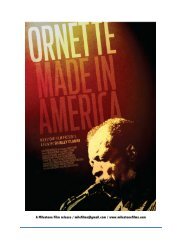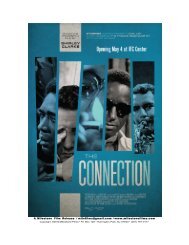ORNETTE Press Kit.8.7.2012 - Shirley Clarke
ORNETTE Press Kit.8.7.2012 - Shirley Clarke
ORNETTE Press Kit.8.7.2012 - Shirley Clarke
Create successful ePaper yourself
Turn your PDF publications into a flip-book with our unique Google optimized e-Paper software.
Lachman began to direct photography in financially fruitful ventures as well, starting with<br />
Desperately Seeking Susan in 1985. The controversial 1987 picture Less Than Zero, with a<br />
breakout performance by a 22-‐year-‐old Robert Downey Jr., was cut and tamed by studios,<br />
much to the anger of cinematographer Lachman and author of the source material, Bret<br />
Easton Ellis. Not afraid of controversy, Lachman, along with Larry Clark, co-‐directed 2002’s<br />
Ken Park, a graphic look at teenage sexuality and relationships. International bans on the<br />
film’s content prevented it from reaching a large audience.<br />
In 1994, Lachman was invited to join the American Society of Cinematographers, where he<br />
has been one distinguished member among only 340 other prestigious cinematographers.<br />
In the years since, Lachman has achieved his greatest fame. Known for his collaborations<br />
with director Todd Haynes, Lachman has shot I’m Not There, miniseries Mildred Pierce and<br />
Far From Heaven, the latter of which he received an Oscar nomination for Best<br />
Cinematography. He has worked with Steven Soderbergh on Eric Brockovich, Sofia Coppola<br />
on The Virgin Suicides and Robert Altman on A Prairie Home Companion, Altman’s last film.<br />
Quite familiar with the festival circuit, he directed photography for Ulrich Siedl’s Paradise:<br />
Love, which was screened in competition at the 2012 Cannes Film Festival.<br />
The Christian Science Monitor<br />
March 14, 1986/DAVID STERRITT<br />
If the independent movie world has a reigning queen, it must be <strong>Shirley</strong> <strong>Clarke</strong>, who has<br />
been marching — and filming and thinking and experiment — to her own drummer for<br />
some three decades now.<br />
Her latest work, a documentary on saxophonist Ornette Coleman, stands with her best<br />
films of the past. It also sums up the most important currents of her career, weaving them<br />
into a colorful fabric that reveals as much about her own preoccupations — with music,<br />
families, race relations, the passage of time, and the poetic possibilities of time, and the<br />
poetic possibilities of film — as about the man whose life, career and thoughts the movie<br />
explores.<br />
To learn more about Ornette: Made in America and its history, I visited <strong>Clarke</strong> in her digs at<br />
the Chelsea Hotel here, which has long been a home base for artists and writers. <strong>Clarke</strong><br />
began filming Ornette: Made in America around 20 years ago — taking shots of her sax-‐<br />
playing friend just for fun, not realizing he would eventually become the subject of a full-‐<br />
length movie. Although she had used on-‐screen jazz musicians in her 1960 drama “The<br />
Connection,” a groundbreaking study of drug abuse, she had no interest at that time in<br />
making a whole movie on jazz, and declined when a producer suggested such a project.<br />
It was a Coleman concert that changed her mind a few years later. The drummer of his<br />
group had recently quit, and Coleman — in the kind of risky move that has peppered his<br />
career — had invited his son Denardo, who was about 12 years old, to join the combo.<br />
26




